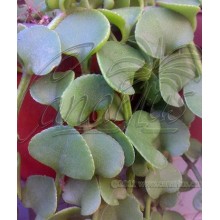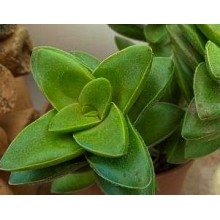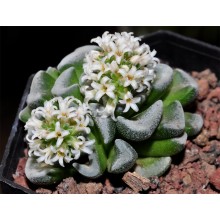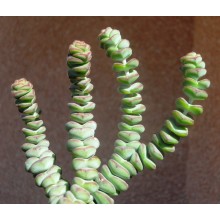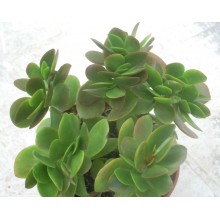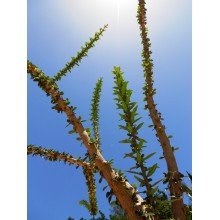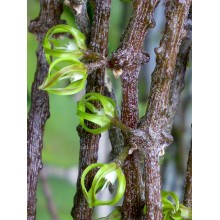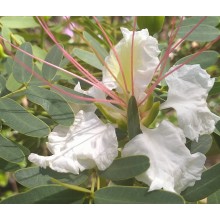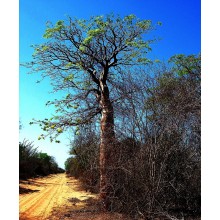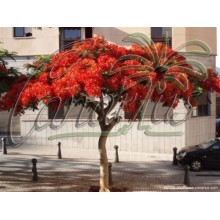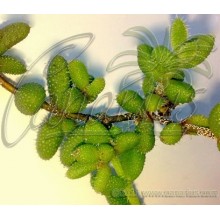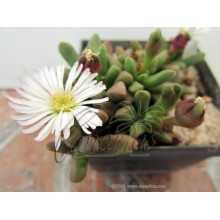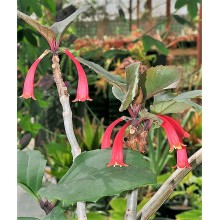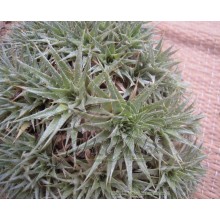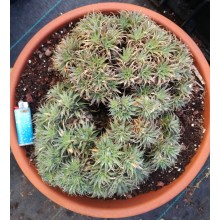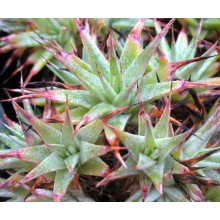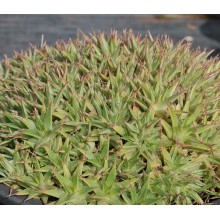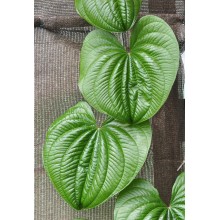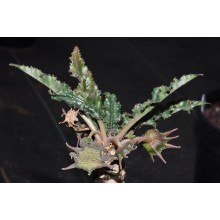Succulents There are 628 products.

World deserts and dry areas are home to the most interesting plants. Canarius offers an increasing selection of succulent plants of maximum quality, because they are grown outdoors, under the full sun of the Canary Islands.
Succulents or "fat plants" are water-retaining species, adapted to dry conditions. They store succum (juice, water) in their leaves, stems or roots, and often show a stout and fleshy appearance.
Subcategories
-
Agave
Agave is a genus of succulent plants from America. Some species grow in cold areas and take hard frost, while some others live in tropical climates. Some are tiny dwarfs and some are giants, up to 2 or 3 m wide.
Cold hardy agaves can create an exotic effect in your garden. Agave species make fine companions to palms or cacti. Variegated agaves are incredibly sought after by collectors. Our web shop offers an ever changing selection of species. We ship bare rooted plants, unless otherwise specified.
-
Aloe, Gasteria & Haworthia
Aloe, Gasteria and Haworthia are three related genera, comprising hundreds of succulent plants. They are all easily grown in pots. A few adapt to low-light levels of indoor conditions and can be grown as house plants.
- Aloe is a genus of about 400 species, native to Africa, Arabia and Madagascar. Small or dwarf aloes are becoming especially popular in colder climates as they can be taken indoors during the hardest months.
- Gasteria includes some 80 species endemic to South Africa, known for their spectacular leaves which are glossy, mottled and textured. They bloom in Spring-Summer with long spikes of small orange flowers. Some species are so variable that we offer particular clones from specific locations.
- Haworthia is a genus endemic to South Africa with about 70 species and a number of local subspecies, varieties and forms. Leaves are often banded, speckled, dotted, or semi-translucent and show wide variations.
-
Crassulaceae
This is a new, growing section of species from the family Crassulaceae. There are about 1,400 species in 33 genera and their distribution is worldwide, but mostly occur in the Northern Hemisphere and Southern Africa, especially in dry habitats. Here you can buy healthy, sun-hardened plants grown in the Canary Islands and shipped to your home.
-
Mesembs
This group of desert plants is briefly named Mesembs because they belong to a botanical family formerly named Mesembryanthemaceae. There are almost 2.000 species, mainly found in Southern Africa, with extreme adaptations to dry habitats. Some are called "living stones", as they look like pebbles. Many are easy to grow and their main need is full sun. Some are difficult because they grow in truly extreme areas.
Our Web Shop offers sun grown healthy plants, with compact and colourful leaves. Some plants are sold as cuttings, and others as rooted plants, of at least two years old.
-
Sansevieria
Recently assigned to the family Asparagaceae, the genus Sansevieria counts about 70 species, nearly all native to Africa, Arabia and Madagascar. Perennial herbs adapted to dry habitats with stiff, succulent leaves, their length ranges from a few centimeters to 2 meters. Sansevieria trifasciata and its many cultivars are among the most popular houseplants, popularly called mother in law's tongue. A well grown plant usually produces a spike of many white, richly scented flowers and then orange berries. Even the rarest species are resistant to neglect, provided you keep them from frost in winter and scorching sun in summer.
-
Hoya
Hoyas are twining vines, with showy exotic flowers, from the rainforests in Asia and Oceania. Most species grow in bright shade or morning sun, but they will also grow indoors as house plants. They are well suited for baskets, trellises or ladders. They tolerate a few weeks of drought but they are sensitive to frost and cold. Many hoyas are easy to grow and bloom, while some are tricky and rare.
-
Asclepiads
Asclepiads or Asclepiadoideae are a subfamily in the Apocynaceae, with about 2900 species. There are lots of leafless stem succulents but also perennial herbs, shrubs, lianas or rarely trees. They produce remarkable flowers, for the complex mechanisms they have developed for pollination. Many species produce an unusual fragrance, often called "carrion", and attracts flies for pollination. -
Caudiciforms
These plants from dry areas produce an unusually thick stem, the caudex. They are also called pachycauls and they have a disproportionately thick trunk, often with few branches. The caudex can be hidden underground, but in most cases they grow upwards, forming spectacular trees. The largest caudiciforms in the world are the baobabs. -
Other succulents
Here you will find all those species of desert plants that are not included in their own category. We will place here all plants from unusual families, other than Agaves, Aloes, Crassulaceae, Sansevieria, Mesembs, Epiphytic cacti, etc.
-
Crassula spathulata
Crassula spathulata
NEW ! - Branched Plant. Creeping or mat forming crassula, from rocky outcrops along forest margins in South Africa. If grown in full sun the leaves may turn intense green. Good for baskets.
10,80 € -
Crassula x 'Celia'
Crassula x 'Celia'
This hybrid was made by crossing two compact species of Crassula, in order to obtain a cute, "living-stone" plant, resmbling indeed a Titanopsis.
16,80 € -
Crassula x Jade Necklace
Crassula x Jade Necklace
Beautiful ornamental cross of crassulas, resembling a "Jade Necklace", with jade-green, red-edged leaves and rather large, pink-tinged flowers
10,60 € -
Crassula x Pretoria Hybrid
Crassula x Pretoria Hybrid
NEW ! - This hybrid turns hot red in full sun. It came from Pretoria and it probably has "blood" of Crassula cultrata
10,50 € -
Crescentia mirabilis
Crescentia mirabilis
Shrub or small tree with spreading stems, and small ovate leaves, just like some Didieraceae from Madagascar. Flowers are large and weird, bat pollinated. It is a relative of the common Calabash Tree, adapted to harsh coastal conditions.
72,00 € -
Cynanchum luteifluens
Cynanchum luteifluens
Green climbing stems, often streaked and dotted with silvery wax. It bears beautiful flowers, lime yellow with a pure white centre. This "caustic vine" is native to Madagascar and its former name was Cynanchum decaisneanum.
21,30 € -
Cynanchum marnierianum
Cynanchum marnierianum
Fascinating hanging plant from Madagascar. Stems are rough and thin. New branches are green and they get browner as the grow. Its beautiful flowers resemble small green Chinese lanterns.
17,20 € -
Delonix decaryi
Delonix decaryi
1-2 year old seedling, H:40-70 cm. This is one of the few species of Delonix that grows as a "bottle-tree" , like a baobab. It is native to the dry South of Madagascar, where it grows together with other succulent plants and caudiciforms. Adult "bottle-trees" are very beautiful when they get covered of plenty of flowers.
45,00 € -
Delonix floribunda
Delonix floribunda
Another interesting Delonix from Madagascar. It is very adaptable and can attain anything from 3 to 12 m in height. Flowers lack petals but they are very beautiful, with lots of golden stamens shown when the tree is still leafless. We grew some plants in 35 cm pots and they started blooming beautifully after about 5 years, when they were just 1.5 m tall.
72,00 € -
Delonix regia
Delonix regia
This is the dream tree of the tropics, often considered the most beautiful of all flowering trees. Commonly called Royal Poinciana or Flamboyant. Its showy red flowers are the essence of the tropics.
46,20 € -
Delosperma echinatum
Delosperma echinatum
NEW ! - Three unrooted cuttings of 6-8 cm. beautiful, unusual succulent leaves, densely covered in glossy translucent "hairs". These are visible adaptations to catch moisture from fogs.
10,90 € -
Delosperma esterhuyseniae
Delosperma esterhuyseniae
Cont.= 6 cm. Compact, clumping plant, 6-15 cm in diameter, with a central rootstock. Dark green or reddish leaves and white, 1,5 cm flowers. Native to the Uniondale district of the W. Cape of South Africa. Winter-growing but enjoys some summer rain.
10,40 € -
Deuterocohnia brevifolia ssp. chlorantha
Deuterocohnia brevifolia ssp. chlorantha
Clump of 6-10 heads - Small, terrestrial, cushion-forming plant species. It is probably one of the cold hardiest of the bromeliads.
31,00 € -
Deuterocohnia brevifolia ssp. chlorantha –LARGE
Deuterocohnia brevifolia ssp. chlorantha –LARGE
Clump of >30 heads. 12 cm diameter ! - Small, terrestrial, cushion-forming plant species. It is probably one of the cold hardiest of the bromeliads.
151,30 €
At the moment there are few products in this category Succulents

























